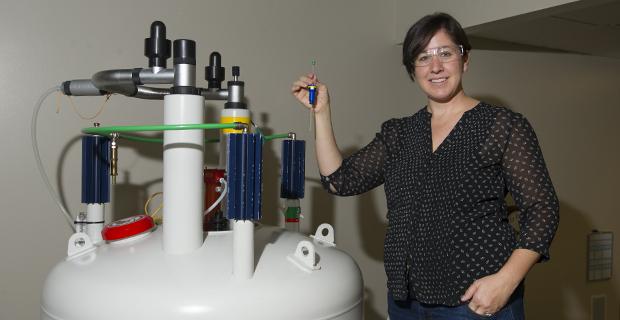
A paper co-authored by Lisa Warner, an assistant research professor in the Biomolecular Research Center, looks at how Clostridium thermocellum breaks down and converts cellulosic biomass to produce biofuels, including hydrogen and hydrocarbons, while also surprisingly decreasing the amount of CO2 released as a waste byproduct.
“CO2-fixing one-carbon metabolism in a cellulose-degrading bacterium Clostridium thermocellum” was published in the journal Proceedings of the National Academy of Sciences of the United States of America. Researchers are affiliated with the U.S. Department of Energy’s National Renewable Energy Laboratory (NREL).
C. thermocellum is among the most efficient bacteria known for directly converting cellulosic materials (a component of plant cell walls) into hydrogen and hydrocarbon biofuels. Normally, CO2 is created as a byproduct. But the researchers found that this microbe can recapture some of the CO2 released during the growth process.
In this case, the researchers were able to convert CO2 to formate, which is not a greenhouse gas. The two chemicals look remarkably similar and are almost indistinguishable using a mass spectrometer. Warner’s role was to definitively discriminate between the two, which she did using nuclear magnetic resonance spectroscopy.
While researchers have known for a while that many species of bacterium are capable of CO2 uptake, until now they didn’t know exactly how. This research identified a new metabolic route previously unknown to the scientific community.
Using carbon isotopes coupled with mass spectrometry analysis, the researchers were able to track how CO2 enters the cell, identify the enzymes critical to CO2 uptake, and discover how CO2 incorporates into products. Previously, the pathway was not associated with the role of carbon dioxide assimilation (otherwise known as CO2 fixation).
NREL researchers and their collaborators determined adding bicarbonate increased the apparent carbon efficiency of C. thermocellum from 65.7 percent to 75.5 percent. The finding underscores the metabolic plasticity of the microbe and raises various possibilities about how the bacterium is able to use both organic carbons and CO2 without breaking the rules of thermodynamics in energy conservation. The discovery also provides a paradigm shift in the fundamental understandings of carbon metabolism in a cellulose degrading bacterium.
“Now that we’ve shown we have a novel pathway we can take advantage of the enzymes that convert CO2 to something else and create a cocktail of molecules with the least amount of noxious byproducts,” Warner said.
Warner’s co-authors from NREL are Katherine Chou, Wei Xiong, Lauren Magnusson and Pin-Ching Maness. Two BioEnergy Science Center (BESC) co-authors are Paul Lin and James Liao from the University of California, Los Angeles.
The latest research into the bacterium was financed by the NREL Director’s Fellowship Program, Energy Department’s Fuel Cell Technologies Office, and the Office of Biological and Environmental Research in the DOE Office of Science.
Warner earned her B.S. in chemistry from Boise State in 2002 before heading to the University of Colorado, Boulder, where she finished her Ph.D. in biochemistry in 2011.
Author
Kathleen Tuck
Source
Boise State University, press release, 2016-12-07.
Supplier
Boise State University
National Renewable Energy Laboratory (NREL)
Proceedings of the National Academy of Sciences of the USA (PNAS)
US DOE Office of Science (SC)
Share
Renewable Carbon News – Daily Newsletter
Subscribe to our daily email newsletter – the world's leading newsletter on renewable materials and chemicals









